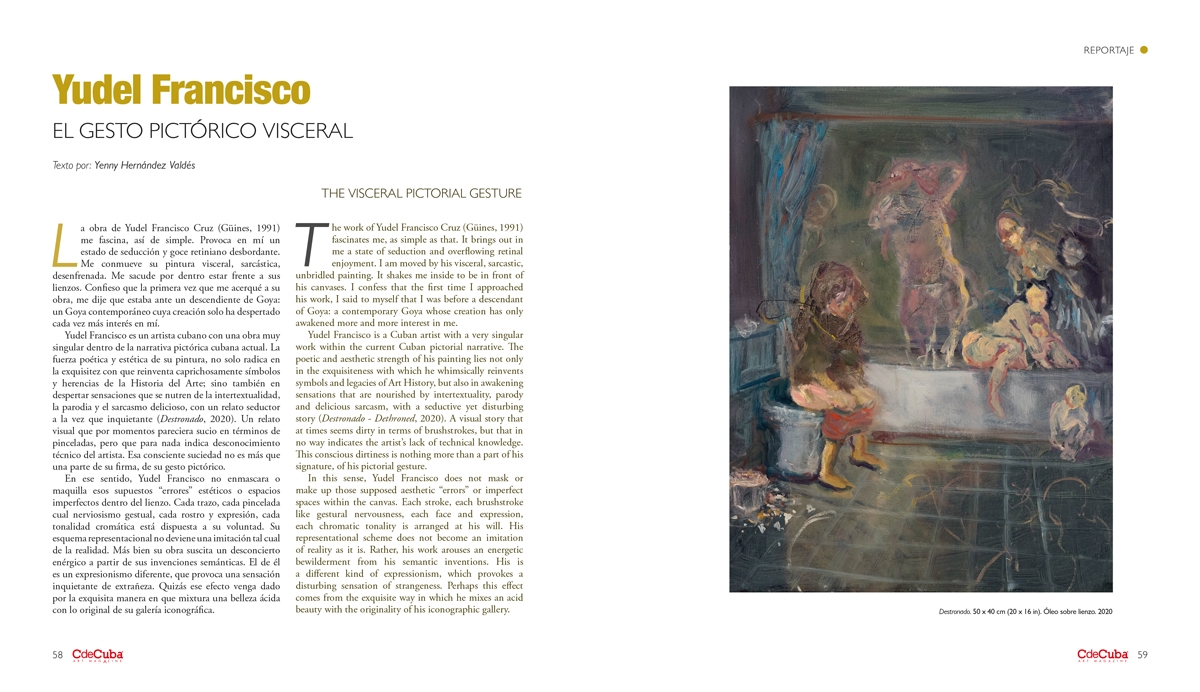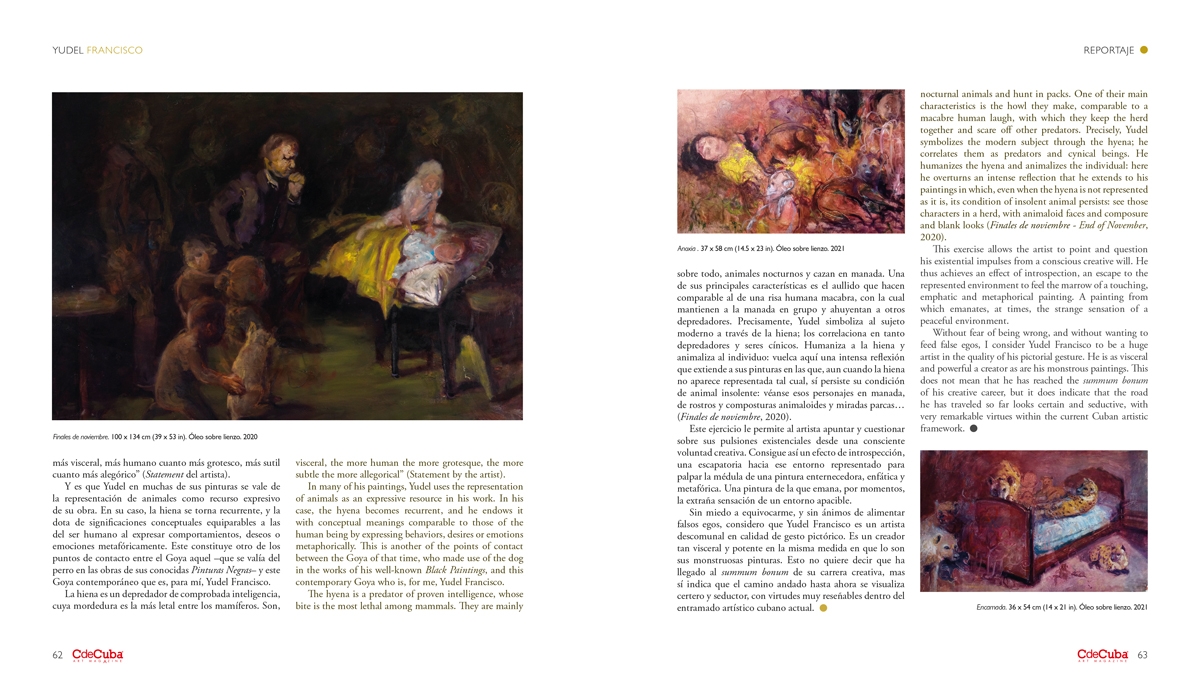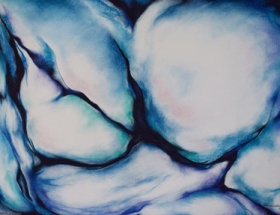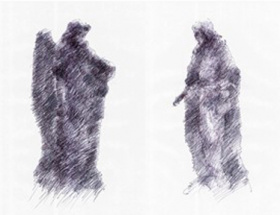The Visceral Pictorial Gesture
By Yenny Hernandez Valdes
The work of Yudel Francisco Cruz (Güines, 1991) fascinates me, as simple as that. It brings out in me a state of seduction and overflowing retinal enjoyment. I am moved by his visceral, sarcastic, unbridled painting. It shakes me inside to be in front of his canvases. I confess that the first time I approached his work, I said to myself that I was before a descendant of Goya: a contemporary Goya whose creation has only awakened more and more interest in me.
Yudel Francisco is a Cuban artist with a very singular work within the current Cuban pictorial narrative. The poetic and aesthetic strength of his painting lies not only in the exquisiteness with which he whimsically reinvents symbols and legacies of Art History, but also in awakening sensations that are nourished by intertextuality, parody and delicious sarcasm, with a seductive yet disturbing story (Destronado – Dethroned, 2020). A visual story that at times seems dirty in terms of brushstrokes, but that in no way indicates the artist’s lack of technical knowledge. This conscious dirtiness is nothing more than a part of his signature, of his pictorial gesture.
In this sense, Yudel Francisco does not mask or make up those supposed aesthetic “errors” or imperfect spaces within the canvas. Each stroke, each brushstroke like gestural nervousness, each face and expression, each chromatic tonality is arranged at his will. His representational scheme does not become an imitation of reality as it is. Rather, his work arouses an energetic bewilderment from his semantic inventions. His is a different kind of expressionism, which provokes a disturbing sensation of strangeness. Perhaps this effect comes from the exquisite way in which he mixes an acid beauty with the originality of his iconographic gallery.
In works such as La Partida(2020) (The Game), boredom and despair are condensed with love and salvation. Yudel converges frightened and anguished looks with gestures and attitudes suggestive of muted energy. He contrasts all this with nervous brushstrokes of whites, ochers and blacks. He himself is even part of the work, in the background, like an expectant portrait that observs from another dimension the scene he recreates from the other side of the canvas. He then becomes part and couterpart of his creative process, as did also great artists of the History of Art, some of whom have clearly influenced him.
Earlier I referred to Yudel Francisco as a contemporary Goya and it was not for pure discursive gratuity. Like that great of Spanish painting, Yudel seems to me an elusive of any academic guideline or classificatory movement of art. He is a cultist of the frenetic, imperfect brushstroke; he is a cultist of distorted faces, of tedious looks, of dull scenes with phantasmagoric nuances, of his own compositions in which time seems to subtract itself, to slowly fade away in the pictorial treatment of lights.
Like Goya, Yudel Francisco offers us his reflections on the subject and his behaviors. His aesthetic whims tell us about an artist who has found in painting the ideal medium from which to say and question the signs of the human species with a very peculiar aesthetic language. He assumes a metaphorical discourse that feeds on his personal experience: “They are, as I understand my pieces, the metatext of my environment: the more real the more visceral, the more human the more grotesque, the more subtle the more allegorical” (Statement by the artist).
In many of his paintings, Yudel uses the representation of animals as an expressive resource in his work. In his case, the hyena becomes recurrent, and he endows it with conceptual meanings comparable to those of the human being by expressing behaviors, desires or emotions metaphorically. This is another of the points of contact between the Goya of that time, who made use of the dog in the works of his well-known Black Paintings, and this contemporary Goya who is, for me, Yudel Francisco.
The hyena is a predator of proven intelligence, whose bite is the most lethal among mammals. They are mainly nocturnal animals and hunt in packs. One of their main characteristics is the howl they make, comparable to a macabre human laugh, with which they keep the herd together and scare off other predators. Precisely, Yudel symbolizes the modern subject through the hyena; he correlates them as predators and cynical beings. He humanizes the hyena and animalizes the individual: here he overturns an intense reflection that he extends to his paintings in which, even when the hyena is not represented as it is, its condition of insolent animal persists: see those characters in a herd, with animaloid faces and composure and blank looks (Finales de noviembre – End of November, 2020).
This exercise allows the artist to point and question his existential impulses from a conscious creative will. He thus achieves an effect of introspection, an escape to the represented environment to feel the marrow of a touching, emphatic and metaphorical painting. A painting from which emanates, at times, the strange sensation of a peaceful environment.
Without fear of being wrong, and without wanting to feed false egos, I consider Yudel Francisco to be a huge artist in the quality of his pictorial gesture. He is as visceral and powerful a creator as are his monstrous paintings. This does not mean that he has reached the summum bonum of his creative career, but it does indicate that the road he has traveled so far looks certain and seductive, with very remarkable virtues within the current Cuban artistic framework.






